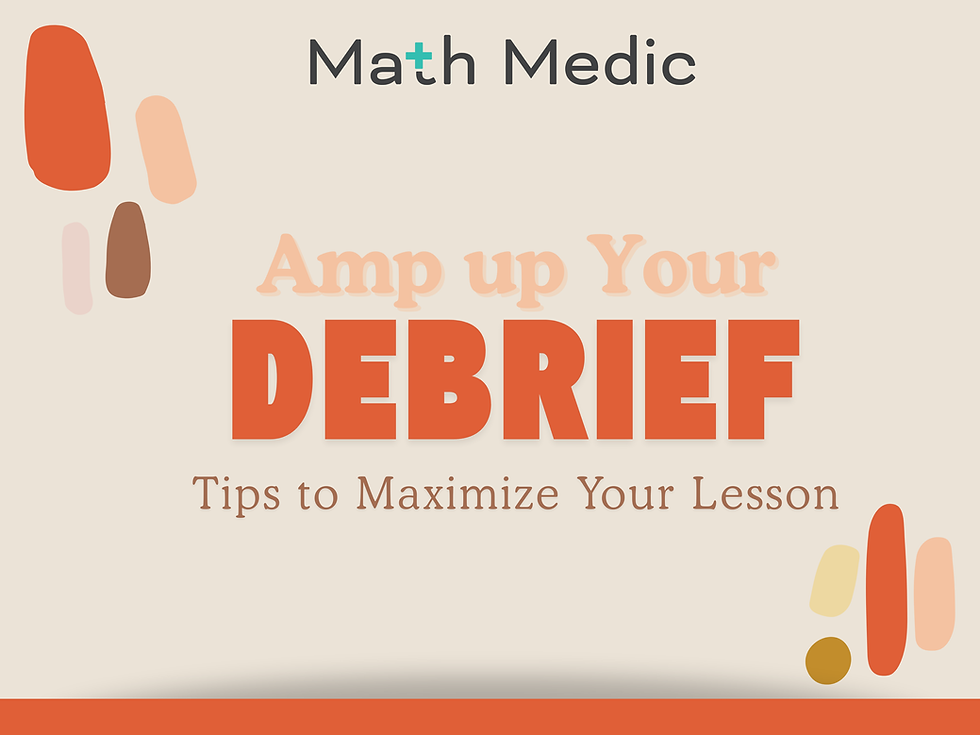Decision Making in the Classroom
- Sarah Stecher

- Jan 28, 2023
- 4 min read
Updated: Feb 16
Teachers make hundreds of decisions every day.
Do I mark the student tardy for being 1 minute late?
Do I call the groups back together even though not everyone is done with the activity?
Do I interject in a group conversation when they’re going down the wrong path?
Do I correct that mistake in a student’s response or let it go?
Do I say something to the student who has their phone out?
Do I give the student whose parent emailed me an extension on their assignment?
Do I call on a specific student to share or ask for volunteers?
This list could go on and on. It feels like every minute of the day we have to make some decision that doesn’t have a clear cut answer. And while that can make our jobs very stressful, it also highlights our agency.
In education we talk a lot about constraints. Limited time. Limited funding. Limited staff. Limited information. Limited support. Limited background skills.
But within those constraints remains our personal agency to make decisions in our classroom that have a direct effect on students, often greater than we know. Deborah Ball from the University of Michigan calls these our “discretionary spaces.” It’s all the areas where we get to choose, where we must choose, and where we must come to terms with the consequences of our choices, whether good or bad.
The truth is that the vast majority of our decisions in the classroom are not choices between the right thing and the wrong thing, or the good thing and the bad thing. Those choices are simple. What makes decision making complex is choosing between two things when both have potential benefits and potential drawbacks, many of which we probably can’t pinpoint right at that moment.
We can not get around making tough decisions. But what if we had a greater awareness of the potential effects of our discretionary spaces? What if we considered more carefully how a small decision like who should share their work at the board could disrupt certain patterns and cultivate new ones?
The goal is not to overthink each and every decision to the point that we are paralyzed and can’t enjoy the work we get to do with students. Instead, I want to suggest a few new perspectives or priorities we can incorporate into our decision making framework.
We already think a lot about how much time something will take and if we’re willing or able to make room for it. We also think about how a certain decision will affect our ability to effectively manage a classroom. And there’s no getting around the consideration of how our decisions will affect students’ performance on classroom and standardized assessments.
Here are two additional perspectives I’ve been thinking about more recently:
Math identities
Status
Let’s unpack each of them.
Math Identities
What students experience in our math classroom shapes their view of mathematics and their own role in it. Students pick up on many small and large cues that communicate to them what the mathematical discipline is all about and if they have a place in it. Decisions about what tasks we choose to use, what mathematicians we choose to highlight, what responses we choose to publicly praise, and whose work we choose to go up on the board (among many others) help students come to these conclusions. Is math only for the “smart kids”? Do I have to be fast to be good at math? Is it all about the correctness of my final answer or does my thinking and reasoning matter?
The next time you’re making a classroom decision, ask yourself:
What does this decision communicate about what it means to do mathematics and who does mathematics?
Status
Our classrooms either disrupt the inequities of the outside world or perpetuate them.The fact that some students have certain advantages over others, whether financial, familial, or other is indisputable and is way beyond any one individual’s ability to solve. The fact that our students come in with vast differences in knowledge, skills, lived experiences, and support systems is also a given. The question we must ask ourselves is if our math classrooms exacerbate that difference or leverage that difference for the good of all students in the class. This leveraging can mean honoring and capitalizing on students’ diverse experiences, but it can also mean creating a space that disrupts some of the problematic patterns of dominance and marginalization. How do I delegate some of the authority that I have simply because I am the teacher and considered the “expert” back to students? How do I position students who are quieter, often ignored, or seen as “not smart” in favorable ways to increase their status among their peers?
The next time you’re making a classroom decision, ask yourself:
What does this decision communicate about who holds the power and whose ideas are worth listening to?
The decisions we make shape the experiences of students in our classrooms– the big decisions about instructional models and assessment policies, as well as the small decisions we make over and over, like calling on the first student who raises their hand. What priorities shape your decisions? Do any of those priorities need to be reevaluated? Who could you ask to help you clarify, strengthen, or refine those priorities?



